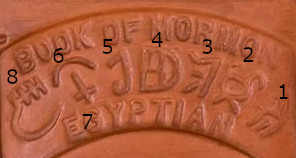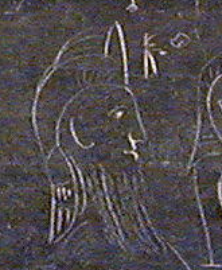There is not much that we have from the Gold Plates of what exactly the Reformed Egyptian of the Book of Mormon looked like. The writings from Michigan are possibly the language that Mormon used to write the history of the Nephite Nation. I do testify that the writings from the Michigan Artifacts are indeed a form of Reformed Egyptian and they do represent a coherent language. I am still working the decipherment and will report this in other articles and videos.
Here, I am showing Reformed Egyptian from church historical records and a reproduced artifact.
This first image is from the Joseph Smith Papers and it is easy to see the influence of Demotic in it.

This second image also represents the language on the plates. This image shows Demotic Egyptian mixed with Reformed Egyptian and one symbol that is unique to the artifacts from Michigan. All of this shall be examined and explained below:

One interesting fact is that both the document from the Joseph Smith Papers and the artistic trinket are being used to educate one on how to write “Book of Mormon” in the ancient Nephite Reformed Egyptian language. An uneducated mind may easily ask how they seem so different from each other. This may even cause a loss in faith.
Lets first go over the writings given to us by Frederick G. Williams.

The Name Mormon in the Joseph Smith Papers
The word Mormon is the symbol that looks like Cp. The image below explains what the Cp really is.

These three letters MRN are apparently how Mormon wrote his name. The M is the mathematical subset symbol. The R is the forward slash. The N is inverted and looks like a fish hook. It is very telling that this writing is using the demotic alphabet which was the new method of writing in Nephi’s day. Demotic Egyptian first came on the scene in Egypt at about 650 BC.
The Word Book in the Joseph Smith Papers

The word “Book” is somewhat like a hieratic version of a roll of papyrus used for writing except that it is inverted. The representation of the papyrus is the horizontal bottom line with two dots below it. On top of the papyrus symbol is the letter R written as a forward slash.
In Egyptian (Middle Kingdom Hieroglyphs, Hieratic, or Demotic), symbols are often laid out horizontally or vertically. The papyrus symbol is a perfect example of how direction of a symbol is not consistent. In looking at hieroglyphs, the papyrus on the image below is the long narrow rectangle with the small w attached to it. The small w is the two dots on the Reformed Egyptian word for book.
In this image of hierglyphs, you also encounter a different way of writing an R. In the older hieroglyphs, the R is written as the oval circle which Egyptologist will claim represents a mouth. A Demotic variant is the perfect circle which is also used as an R. Now you are aware of three versions of the letter R in Egyptian – 1. Forward Slash (demotic), 2. Mouth (hieroglyph), and 3. Perfect Circle (demotic). A fourth will be shown later.

The word for “To Know” may not be the same as the word “Book”. In fact the commonly used words for book in Demotic is md or sh. But in this Reformed Egyptian from the Joseph Smith papers, it appears to be closer to the Egyptian word for “To Know”. It uses the forward slash for the R with a papyrus symbol below it.

The next snippet says that it means interpretation of languages. What is not clear is which one of them means Interpretation, and which one means Language. The one on the left appears to be the same word as Book just described. The difference is that it uses the demotic circle for the letter R combined with the papyrus. As previously described, this is a close match to the word “To Know” shown in the dictionary entry above. The symbol to the right (languages) has the papyrus symbol, but I am unable to match it to anything in the dictionaries.

The Brick from the Nauvoo Mercantile Exchange
Now lets dissect the trinket from the Nauvoo Mercantile Exchange Store. There is a lot to be learned from here. In fact, this trinket proves two things.
- Joseph Smith knew Demotic Egyptian.
- Reformed Egyptian existed in North America.

Symbol 1
Symbol 1 looks like a turned over 3. This is a feminine definite article in Demotic for the word “The”. The example in the image below is an upright 3. In the trinket, the feminine definite article (The) is turned over on its side – a common practice in Demotic.

Symbol 2
This is the word for Book. The two legs on the bottom represent the two ticks for the papyrus. The circle is the phonetic R. This matches closely to the word book reported on the Joseph Smith Papers version of the symbol for Book. The two hooks at the top are likely artistic to represent the hooks for holding plates together.

Symbol 3
I personally have been teaching people about the writings on the Michigan Artifacts proclaiming translations since 2017. One of the first letters to figure out was the letter N. I will never forget the time I sat in the Macaroni Grill restaurant in Tucson (now closed) writing the name of Noah on a napkin showing my kids. It is the symbol used here followed by the proto-caananite ayin symbol which looks somewhat like a hand drawn eye. For that is how Noah is spelled on the below artifact. Another artifact shows Noah standing personifying the symbol with this two arms outstretched and his leg kicked out – making his person look like the symbol.



I am making the claim that the Michigan Script symbol of the letter N is placed in a perfect spot to mean the word “of”. I shall now defer to the Egyptian textbooks for you to see and validate this.




Symbol 4 and Symbol 6


Symbols 4 and 6 are simply variations of the Demotic M – Symbol 6 being turned on its side. Symbol 4 is built out with more content – it is turned into a symbol used in the John Whitmer Caractors document three times. Symbol 4 is based on the demotic letter M.
Symbol 5

Symbol 5 now becomes a fourth variation for the letter R. The most common ways in Demotic Egyptian to write an R are the forward slash and the circle. At first I did not recognize the R in this artifact as I did not find it in the Chicago Demotic Dictionary. In order to find it, I had to search from early demotic texts dating closer to 500 BC. Leonardo Caldas Viera also gives one example of this version of the letter R.

A Second source of the symbol being an R is given in the image below. This source comes from publication Two Early Demotic Ostraca from the Valley of the Kings written by Eugene Cruze Uribe and Steven Vinson from the Journal of the American Research Center in Egypt 2005/2006 Volume 42 downloaded from JSTOR. The authors transliterate the symbol as an R.


This third example comes from the book Saite and Persian Cattle Documents written by Eugene Cruze Uribe. This book focuses on early Demotic writings.

Symbol 7


This is the demotic vowel for an I or E. It looks like a sword or an upside down crucifix. The Chicago Demotic Dictionary has the curvy horizontal line on the bottom. In actual usage, sometimes the line is a little above the bottom. Sometimes, there is no line at all.
Symbol 8

8. This is a demotic N with a fancy creative looking top.
Putting it all together

Conclusion
The brick sold at the Nauvoo Mercantile Store spells out “The Book of Mormon” in Reformed Egyptian. It is a mix of early demotic Egyptian, one symbol from the Michigan Artifacts, and one symbol, book, that is very much reformed from the original language.
Evidently, Joseph Smith knew what he was doing.